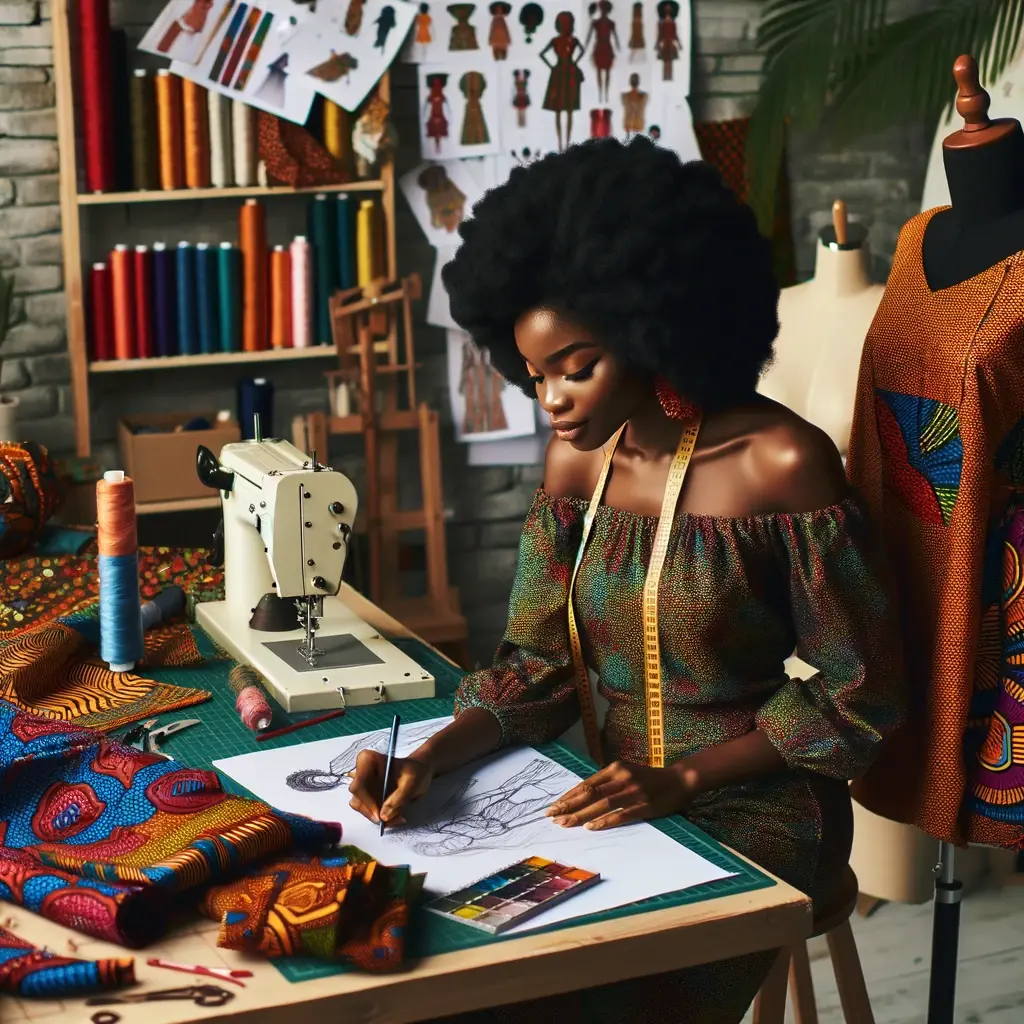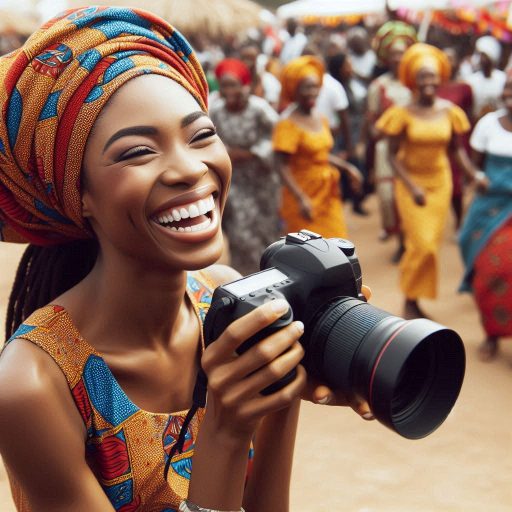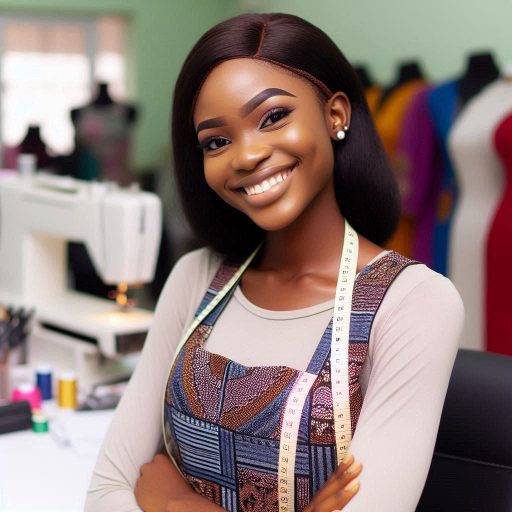Introduction
Let’s delve into fashion designer salaries in Nigeria.
Welcome to our exploration of the vibrant fashion industry in Nigeria.
This sector stands as a beacon of creativity and innovation, nurturing an abundance of talented fashion designers.
These artisans not only define contemporary styles but also significantly contribute to the Nigerian economy.
Their roles have evolved, pushing the boundaries of traditional attire to international haute couture, spotlighting Nigeria on the global fashion map.
The importance of fashion designers in Nigeria’s economic fabric cannot be overstated.
They create jobs, foster entrepreneurship, and promote cultural heritage.
This rise in prominence parallels the global fashion scene’s dynamic shifts, indicating a promising trajectory for local designers.
As such, understanding the financial aspects of this profession becomes crucial.
This blog post aims to delve into fashion designer salaries in Nigeria by 2024.
We seek to provide insights into compensation trends, challenges, and opportunities within the industry.
Our exploration will offer valuable information for aspiring designers, industry stakeholders, and fashion enthusiasts alike, painting a clear picture of what the future holds financially for those in the Nigerian fashion scene.
Factors Influencing Fashion Designer Salaries in Nigeria
Several factors affect fashion designer salaries in Nigeria. Each plays a crucial role in determining earnings. Let’s delve into them.
Impact of Experience and Reputation
Experience significantly boosts a fashion designer’s salary.
Novice designers earn less. Over time, building a robust portfolio paves the way for higher wages.
Reputation also matters. Designers renowned for quality and creativity command higher fees.
They often work with high-profile clients. Thus, both experience and reputation serve as major salary boosters.
Location and Its Effect on Salaries
The salary disparity between urban and rural areas is evident.
Urban designers generally earn more. Cities like Lagos and Abuja have a higher cost of living and a more vibrant fashion scene.
This urban demand raises designer fees. Conversely, rural areas offer limited opportunities, reflecting in lower salaries.
The Role of Education and Specialized Training
Formal education and specialized training significantly impact earnings.
Designers with degrees or certifications from esteemed institutions often have an edge.
They possess advanced skills and knowledge, making them more valuable.
Employers and clients recognize this value, reflecting in their compensation packages.
Market Demand for Fashion and Design Trends
Market trends also dictate salaries.
When certain styles become popular, designers skilled in those trends see a salary spike.
The Nigerian fashion industry often experiences shifts in demand. Staying current with trends can, therefore, lead to better earnings.
Additionally, designers who anticipate or set trends enjoy even greater financial advantages.
Essentially, a mix of experience, reputation, location, education, and market trends shapes fashion designer salaries in Nigeria.
Keeping abreast of these factors can help aspiring designers navigate their careers more effectively.
Read: How Nigerian Fashion Designers Impact Local Economies
Average Salary Range for Fashion Designers in Nigeria in 2024
The fashion industry in Nigeria continues to grow at an impressive pace.
As it evolves, so do the opportunities and remuneration for fashion designers.
In 2024, the salary range for fashion designers in Nigeria varies significantly based on experience.
Here, we break down these ranges from entry-level positions to senior-level roles.
Entry-Level Fashion Designer Salaries
- Starting salaries reflect newcomers’ potential more than their experience.
- Entry-level designers typically earn between ₦50,000 to ₦100,000 monthly.
- Factors like educational background and internships can influence starting pay.
- Designers who freelance might earn more per project but face inconsistent income.
- Most find employment in local fashion houses or start with online boutiques.
Mid-Level Fashion Designer Salaries
- This category involves designers with 3-6 years of experience.
- Monthly salaries range widely from ₦120,000 to ₦250,000.
- Designers may now specialize in areas like bridal, traditional, or kids’ wear.
- Some start establishing their brand or work for well-known fashion houses.
- Networking and portfolio quality significantly impact income growth at this stage.
Senior-Level Fashion Designer Salaries
- Designers with over 7 years of experience fall into this category.
- Senior fashion designers can expect to earn between ₦300,000 and above monthly.
- Many run their successful fashion brands or hold top positions in established companies.
- Reputation, brand value, and international exposure can drastically increase earnings.
- Senior designers often diversify into fashion education or consultancy, widening income sources.
The fashion industry in Nigeria offers a broad salary spectrum in 2024, reflecting the diverse expertise levels of fashion designers.
Beginners start on modest incomes, but as they gain experience, specialize, and build their brand, their earnings potential increases significantly.
Senior designers enjoy lucrative salaries, highlighting the financial rewards of career progression within the fashion industry.
These trends mirror the industry’s dynamic nature and its capacity to support various career pathways.
Read: Nigerian Fashion Designers: Blending Tradition & Modernity
Comparing Salaries: Independent Designers vs. Employed Designers
In the fashion industry, the debate between the earning potentials of independent designers versus employed designers remains evergreen.
This section delves into both worlds, shedding light on their income models, the influence of business ownership, and the pros and cons tied to each path.
Overview of Income Models
Independent designers often benefit from a direct-to-consumer sales model.
This approach allows them to set their prices. They retain more profit per item sold but face higher risks and upfront costs.
Their income fluctuates based on sales, popularity, and the ability to manage business expenses effectively.
Employed designers, conversely, enjoy a more stable income.
They typically receive a monthly salary, bonuses, and sometimes, a commission on sales or a percentage of the profits if their designs perform exceptionally well.
This model offers financial stability but lacks the high-income potential of successful independent designers.
Business Ownership and Income Potential
Business ownership dramatically affects income potential.
Independent designers, as business owners, have unlimited growth potential.
They can expand their brand, diversify product lines, and scale their businesses globally.
However, success requires savvy marketing, financial management, and the ability to anticipate fashion trends.
For employed designers, growth in income is often linear, tied to promotions, experience, and the success of the company they work for.
Although less risky, the ceiling for their earnings is invariably capped compared to entrepreneurs who hit a high market demand.
Benefits of Being Employed
- Stable Income: A predictable monthly salary helps with personal budgeting and financial planning.
- Learning Opportunities: Working for a company provides a platform to learn from experienced designers and gain exposure to various aspects of the fashion industry.
- Less Risk: Employed designers are not directly affected by market downtrends as independent designers are.
Downsides of Being Employed
- Income Limitations: The potential to earn significantly more is stifled by the salary structure.
- Limited Creative Freedom: Designs often need to align with the company’s vision, restricting creativity.
- Dependency: Career progression depends on company policies and market performance.
Benefits of Being an Independent Designer
- Unlimited Earnings: Income potential escalates with brand growth and market reach.
- Full Creative Control: Freedom to experiment and design according to one’s vision.
- Ownership: Pride in building something from scratch and being your own boss.
Downsides of Being an Independent Designer
- Financial Risk: Higher upfront costs and the risk of business failure.
- Unpredictable Income: Sales can fluctuate widely, impacting stability.
- Responsibility: The burden of managing all aspects of the business rests on their shoulders.
Both paths offer distinct advantages and challenges.
The choice between being an independent designer or an employed designer in Nigeria greatly depends on personal preferences, risk tolerance, and career aspirations.
Ultimately, success in the fashion industry requires passion, resilience, and an unyielding commitment to innovation, regardless of the route taken.
Read: The Influence of Nigerian Fashion Designers Worldwide
Strategies to Increase Earnings as a Fashion Designer in Nigeria
Importance of building a strong personal brand
In the fast-paced world of fashion in Nigeria, setting yourself apart is key.
A robust personal brand can act as a beacon, attracting clients.
It tells your story, showcases your unique style, and builds trust. To start, refine your logo and professional imagery.
Consistently use these across all platforms. Remember, your brand is your promise to your customer.
Networking and collaboration with fellow designers and influencers
Networking can’t be overstated in its importance. Collaborating with peers opens up new avenues for growth.
Attend industry events, join fashion groups, and be active on social media.
These actions help you gain visibility and establish meaningful connections.
Working with influencers also puts your designs in front of a wider audience.
Choose collaborators wisely to ensure they align with your brand’s values.
Engaging in continuous learning and skill enhancement
The fashion industry evolves rapidly. To stay relevant, continuous learning is crucial.
Take courses in new design techniques and technologies. Follow trends, but also dare to innovate.
This mindset not only refines your craft but also places you ahead of the curve.
Clients seek out designers who offer something different. Be that designer.
Exploring digital marketing to expand market reach
Digital marketing has transformed how fashion is consumed. It allows you to reach a global audience from Nigeria.
Create an engaging online presence. Use social media platforms and your website to showcase your work.
SEO can increase your visibility online. Consider also email marketing to keep your audience engaged.
Show behind-the-scenes processes or share stories about your designs to create a connection with your audience.
Generally, the route to higher earnings in fashion design is multifaceted.
It involves building a strong personal brand, effective networking and collaboration, continuous learning, and leveraging digital marketing.
Each step requires dedication but promises significant rewards. Embrace these strategies to not just survive but thrive in Nigeria’s vibrant fashion scene.

Challenges Facing Fashion Designers in Nigeria Regarding Salaries
In Nigeria, fashion designers face numerous challenges when it comes to their salaries.
These obstacles often stem from external economic and industry-specific factors.
Understanding these hurdles is crucial for both aspiring and established designers.
Below, we delve into some of the main challenges Nigerian fashion designers encounter related to their earnings.
Economic Fluctuations and Their Impact on Disposable Income
Nigeria’s economy often experiences fluctuations. These changes directly affect people’s disposable income.
When the economy dips, consumers cut back on non-essential purchases.
Luxury items, including fashion pieces, usually fall into this category.
Consequently, designers see a decline in sales, affecting their income.
The unpredictable nature of the economy makes it hard for designers to forecast earnings and plan their finances.
Competition Within the Fashion Industry
The Nigerian fashion industry is highly competitive.
New designers emerge constantly, each bringing unique styles and concepts.
This saturation makes it hard for designers to stand out. Established designers must innovate continually to stay relevant.
New designers struggle to make their mark.
This intense competition often leads to a race to the bottom in terms of pricing to attract customers, adversely affecting salaries.
Access to Affordable Materials and Resources
Access to affordable, quality materials poses another challenge.
Import restrictions and tariffs can inflate costs of foreign fabrics and accessories, while locally-sourced materials might not always meet the quality desired.
Designers often have to choose between quality and cost, impacting their final product pricing and profit margins.
High production costs can force designers to set higher prices, potentially reducing their competitive edge in the market.
Additionally, access to manufacturing facilities and skilled labor that meets fashion industry standards can be limited, further complicating production processes and costs.
In short, Nigerian fashion designers navigate a complex landscape marred by economic volatility, stiff competition, and high production costs.
These factors make it difficult for many to achieve a stable and commensurate salary.
To thrive, designers must adapt swiftly, seek innovative solutions, and tirelessly work towards carving a niche for themselves in this vibrant but challenging industry.
Read: Education for Fashion Designers in Nigeria: What You Need
Future Outlook for Fashion Designer Salaries in Nigeria
The future outlook for fashion designer salaries in Nigeria shows promising potential.
Various factors will play pivotal roles. Here, we explore the trends, technological impacts, and government efforts shaping this landscape.
Predicted Trends Affecting the Fashion Industry in Nigeria
- Increased Global Interest: Nigeria’s fashion scene continues to attract global attention. This trend boosts demand for local designs, pushing up salaries.
- Eco-friendly Practices: A growing shift towards sustainability in fashion influences design philosophies and may introduce premium pricing for eco-conscious designs.
- Expansion into African Markets: As Nigerian designers explore broader African markets, their earnings potential increases.
- Rise in Luxury Consumer Segment: The expanding luxury segment in Nigeria’s consumer market suggests higher pay for designers who cater to this niche.
The Potential Impact of Technology and Digitalization on the Fashion Industry
- E-commerce Platforms: Online sales channels expand market reach and revenue opportunities for designers. This expansion could translate into higher salaries.
- Social Media Marketing: Leveraging social media for branding and sales enhances visibility and income, indirectly impacting designers’ pay scales.
- Digital Fashion Tools: Adoption of advanced design software boosts creativity and efficiency, making designers’ work more valuable.
- Virtual Fashion Shows: These events cut down on the costs of physical shows and allow for a broader audience, potentially increasing sales and, in turn, designer salaries.
Government Policies and Initiatives Supporting the Creative Sector
- Funding for Creative Enterprises: Government grants and low-interest loans provide financial support, enabling fashion designers to expand their businesses.
- Training and Development Programs: Initiatives aimed at skill development enhance the quality of design, increasing designers’ marketability and salary prospects.
- Export Support Policies: Policies that ease the process of exporting goods help designers reach international markets, boosting the industry’s overall profitability.
- Intellectual Property Protection: Strengthening copyright laws for designs and brands protects designers’ work, encouraging creativity and innovation.
Overall, the future outlook for fashion designer salaries in Nigeria is bright, influenced by global interest, sustainability trends, technological advancements, and supportive government policies.
These components collectively foster an environment where creativity flourishes, and financial rewards follow.
As Nigeria’s fashion industry positions itself on the world stage, designers stand to benefit from an expanding market reach, enhanced by the digital revolution and reinforced by government initiatives.
Thus, it is an opportune time for fashion designers in Nigeria to innovate and ride the wave of these positive changes, as their potential for increased earnings looks optimistic in the foreseeable future.
Conclusion
We explored the dynamic world of fashion designer salaries in Nigeria.
We highlighted factors like experience, location, and specialization.
Understanding these factors helps navigate the fashion industry’s financial landscape.
Aspiring designers should grasp this to mold their career paths effectively.
The complex interplay of market demand and skill sets significantly influences earnings.
Knowing your worth and the market’s needs positions you well. This knowledge proves crucial in negotiating salaries or setting freelance rates.
We encourage aspiring designers to chase their dreams with tenacity. Challenges exist, but so do opportunities for those ready to seize them.
Equip yourself with industry knowledge, strive for excellence, and never undervalue your creativity.
The journey to becoming a sought-after fashion designer in Nigeria starts with understanding the terrain and continuous growth.
Ultimately, while the path may seem daunting, passion and perseverance are your best allies.
Keep honing your craft, stay informed, and your efforts will pave the way for a rewarding career in fashion design.




